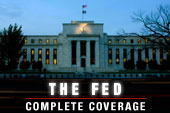The shadow banking system - blamed for aggravating the financial crisis - grew to a new high of $67 trillion globally last year, a top regulatory group said, calling for tighter control of the sector.
A report by the Financial Stability Board (FSB) on Sunday appeared to confirm fears among policymakers that the so-called shadow banking system of non-bank intermediaries continues to harbour risks to the financial system.
The FSB, a task force from the world's top 20 economies, also called for greater control of shadow banking, a corner of the financial universe made up of entities such as money market funds that has so far escaped the web of rules that is tightening around traditional banks.

"The FSB is of the view that the authorities' approach to shadow banking has to be a targeted one," the group wrote in a report, noting the current lax regulation of the sector.
"The objective is to ensure that shadow banking is subject to appropriate oversight and regulation to address bank-like risks to financial stability," it said.
Officials at the European Commission in Brussels also see closer oversight of the sector as important in preventing a repeat of the financial crisis that has toppled banks over the past five years and rocked the euro zone.
The European Commission is expected to propose EU-wide rules for shadow banking next year.
The United States is already rolling out a framework of new rules for the $2.5 trillion money market industry, which pools money from investors to put in low-risk financial assets that resemble deposits in a bank.
During the crisis, heavy exposure to collapsed investment bank Lehman Brothers caused the net asset value of one fund - the Reserve Primary Fund - to drop below $1 per share, breaking an implicit promise of a guaranteed minimum value.
Unlike banks, such funds are not backed up by the Federal Deposit Insurance Corporation, and critics say a sudden depositor flight from the sector could have equally devastating consequences as a traditional run on a bank.
The Financial Stability Oversight Council (FSOC) - a new body of regulators including the Securities and Exchange Commission (SEC) and the Commodity Futures Trading Commission (CFTC) - said last week it would not limit itself to money market funds.
It said that "regulated and unregulated or less-regulated cash management products may pose risks that are similar to those posed by money market funds" and that it would address any risks arising in those areas.
AMERICA HAS LARGEST SYSTEM
The FSB has signaled a two-pronged approach to regulating shadow banking, with tough rules such as possible capital charges and limits on the size and nature of a mainstream bank's exposure to shadow banks.
Other shadow banking activities which are seen as less systemically risky could face greater transparency requirements.
Critics of this regulatory drive say that the definition the FSB uses to describe shadow banks is intentionally vague, allowing them to probe and potentially regulate corners of the financial universe that are seen as harmless.
The FSB said shadow banking around the world more than doubled to $62 trillion in the five years to 2007, and had grown to $67 trillion in 2011 - more than the total economic output of all the countries in the study.
America had the largest shadow banking system, said the FSB, with assets of $23 trillion in 2011, followed by the euro area with $22 trillion and the United Kingdom at $9 trillion.
The U.S. share of the global shadow banking system has declined in recent years, the FSB said, while the shares of the United Kingdom and the euro area have increased.
The FSB advocated better controls, but cautioned at the same time that the sector can also be a source of much-needed credit for business and consumers.
"Non-bank creditors that smell, feel, and sound like banks but aren't in name are clearly the problem; while non-bank creditors that do not, and are not linked to the banking system, surely offer us a welcome reduced dependence on banks," said Pete Han from the Cass Business School in London.
Forms of shadow banking can include securitization, a method to transform bank loans into a tradeable instrument that can then be used to refinance credit, making it easier to lend.
In the run-up to the crisis, however, banks such as Germany's IKB stored billions of euros of such instruments in off-balance sheet vehicles, which later unraveled.
Another example is a repurchasing agreement, or repo, where a player such as a hedge fund or a blue chip company sells securities to a bank, agreeing to repurchase them later.
The bank may then lend those bonds onto another hedge fund, taking a position on the government debt. Such agreements are used by banks to lend and borrow. A risk could arise if one of the parties in the chain collapses.



